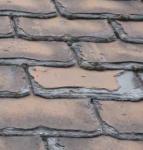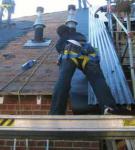Arahina Re Roof Project
By Graham Hepburn
Arahina is one of Marton’s grand buildings and it is also a place where many lives – young and old - have been shaped. Built in 1919 for Alfred Crooke, a retired lawyer and magistrate, Arahina was originally named Astolat after a legendary city mentioned in the tales of King Arthur.
In 1946, the two-storey Tudor-style residence was sold to the New Zealand Girl Guides Association, who renamed it Arahina, which, in Maori, means to lead or to guide.
For the Guides, Arahina was the culmination of a dream to have a dedicated national training centre for its leaders where they could learn about their role in the movement and share ideas. The size of the home was perfect for this and so was the central North Island location of Marton, a junction on bus and train
routes that made it easier for leaders to come from all parts of the country.
In 2000, the Guides sold the property to a local private concern that then onsold it in 2001 to the Institute in Basic Life Principles, a Christian, not-for-profit, nonsectarian training and community service organisation. It is used as a national training centre for the institute’s home education programme and as a national office for the institute’s other ministries. The institute also delivered counselling and training to troubled
youth, addicts or people with disabilities who were referred to it by government agencies. It is also used by the likes of businesses, Christian groups or sports groups for accommodation and functions. With all these different activities housed under one roof, it’s important to have a sound roof so when the historic building’s
bituminised tile roof began to fail, planning began in earnest about how best to replace it in sympathy with the building’s heritage.
As Arahina’s operations manager, Gordon Strong, says: “The roof wasn’t looking very attractive and we could see that something needed to be done before it developed any leaks and so forth.” Wayne Pratt, who was working as a woodwork instructor at Arahina at the time, was designated as project manager for the re-roof and he began researching materials as well as the building’s heritage.
The initial plan was to replace it with a similar product from the United States but that proved problematic. “A friend of mine and I did some pricing and it was going to be pretty expensive,” says Wayne, “ and at the time we couldn’t get a team that was authorised to install it so there would be no guarantees on the product.”
Gordon says the decision to go with metal roofing was based on it being the “most cost-effective and what would last the longest and the corrugated look is out of yesteryear”.
While Arahina, as a complex, has grown over the years with a number of buildings added such as
accommodation blocks and a large hall, the original homestead has nine bedrooms upstairs while the downstairs has three large offices, a commercial kitchen and a dining room that seats up to 90 people.
When the re-roofing project began, heavy tarpaulins were put in place so that day-to-day activities could
continue uninterrupted, which is just as well as the job was tackled during winter when wind, rain and frosts
were an issue.
“The time of year that we were doing - it in June/July – and the pitch of the roof made it a little bit
difficult, and safety was a paramount issue,” says Wayne.
However, Wayne had plenty of labour on hand to help with demolition and the re-roof, calling on his students to help out. Normally, Wayne and his students were involved in the demolition of old homes so they could salvage timber such as rimu and matai, which they would then turn into furniture that they would sell.
Trainees, who normally stay until they are 17 before they are placed with guardians, were also involved
in restoring the downstairs of the homestead to something approaching its original state. Some of Wayne’s senior students helped out on the re-roof, which took about two months with weather interruptions.
Wayne says getting the roof colour right was also something they took very seriously. He says the Ironsand
hue was similar to what had been there before and was in keeping with the colour of roofs of that era.
“We did a bit of research and that colour seemed to come up as the overall colour for grand residences,
“ he says. “My wife is a bit of a historian and that charcoal colour for roofing is one that she identified as





